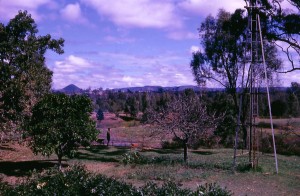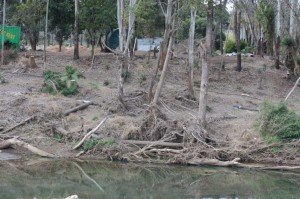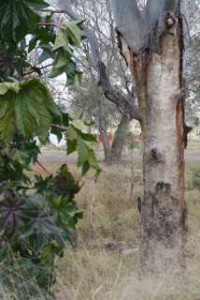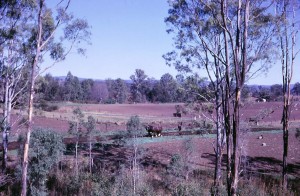 This January has been a big one for commemorations. One year after floods devastated so much of Queensland, we’ve been remembering, being shocked again by images from that time and saluting the courage of the survivors as they rebuild their lives.
This January has been a big one for commemorations. One year after floods devastated so much of Queensland, we’ve been remembering, being shocked again by images from that time and saluting the courage of the survivors as they rebuild their lives.
As the floods filled the news bulletins last year, I could hardly bear to watch. The names of the towns were like a rollcall of all the places I had lived during my childhood: Chinchilla, Dalby, Toowoomba, Helidon, Brisbane… It’s a long time since I lived in any of those places, but still I felt connected to them and to the people who live there.
Now, once more the names of all the places flooded have been in the news. As well as feeling distress again at this natural disaster and its tragic impact, I’m struck by how affecting it is, just hearing the names.
Before January 2011, how many people had heard of Grantham? For me, it was a little town I used to pass through on the way to music exams. A town surrounded by citrus orchards and potato and onion paddocks – a place of roadside stalls and fruit barns and bargains for people out on Sunday drives. Then the highway bypass was built, and it almost fell off the map. Now, all of Australia has heard of Grantham. Say the word and images come immediately: brown floodwater; the tops of rooves and cars with people clinging onto them; Paul Lockyer for the ABC TV News talking to a local who says what happened there was “Armageddon”.
One place which wasn’t mentioned much was the town of Helidon. Because I’ve lived there, I knew it had to be in the path of the wall of water which surged down the Range from Toowoomba, past Murphy’s Creek and on to Grantham. Much of Helidon is on higher ground, well above the level of the creek. But still there were people whose lives were at risk, houses which were ruined – and evidence, a year later, that something savage has occurred. Near what used to be a little park, the bark has been ripped from trees up to the height where the water raged through. Most of the smaller trees are dead, strewn over the creekbed or standing like white skeletons, not just along the creekbank I remember from fifty years ago – the eastern one which fell away steeply below our garden – but as far as the new, January 2011 edge, many metres to the west of where it used to be.
Here are two photos taken at Helidon, in August 2011.
I didn’t name the town in my poem (written over two decades ago), ‘From the Bottom of the Range, the View’. But here it is, the view from Helidon, before the flood.
FROM THE BOTTOM OF THE RANGE, THE VIEW
In the great drifting galleons of the Moreton Bay figs
anchored all round the harbour-garden
of that house in a town
at the bottom
of a range
still young enough to climb from the gaunt, wrinkled hold
to the high, skin-tight masts: How far
can you see? we asked one another
How far?
But always the mountain was in the way. The Great Divide.
Eucalyptus khaki – or through Grandpa’s telescope
broccoli green
On the other side of that range the wheat-flat downs
the property of grandparents a long white house
hard sun and deep black shadows in the earth
cool hollows around a verandah where vines
(wisteria) thick as pythons
curled
all through the nights – short nights of Christmases
in families of beds stretched for miles
around the old grey planks
cousins cousins cousins
aunts and uncles
mothers fathers
tucked securely into childhood rooms (put to sleep
by photographs of themselves on horses
blue ribboned country shows)
the night black as the earth the morning a tinkling of cowbells
in the home paddock, a rustling of mother’s old stockings
(runs of giggles, heel to head) presents unflapping
from Santapaper nests – precious as birds’ eggs
under the roof of rippled tin and the pale
listening wisteria leaves.
How far can you see? How far?
Grandpa sewing sacks, the red monster harvester
churning through chaff – a haystack high
beyond milking bails (squeeze now,
slowly now – watch out
she doesn’t kick)
Beyond the old car Tansy overgrown with weeds, pennyroyal
in wheels whirling round the axle and up
through the driver’s seat springs
How far? What can you see? What – ? Cow dung
in the froth, only an inch of milk in the bucket anyway –
Now, now, Marmalade – let’s have another go)
quiet as the spaces between sunflowers
on the forty-acre block
drifting away for ever the ridges the land the sun
on the miraged downs and somewhere beyond
even that: wilga trees, little towns,
endless land –
Up in the Moreton Bay fig, telescope to the eye – What
can you see? Only the mountain, mother’s big black drum
(liquid manure) three children’s bicycles stacked
against a shed – up among the figs the sky
was a pure blue sea (Run up the sails!
Catch the wind! Anchors up!
We’ll be over the mountain
the Great Divide
by noon – )
Telescope to the eye even the sky came close.
(How far can you see:? How far?)
But always no matter how the wind took our voices
no matter how the galleons bucked and rolled
always the same, smalltown reply:
I can see Toowoomba. I can see the Range. And here
on the other side of the creek in 1963
Old Jack behind a draughthorse
is ploughing a paddock
for potatoes.
Helidon,1963: photo taken by my mother, Isabel Sharp
PS My younger brother, whose memory is often more accurate than mine, says the farmer’s real name was Harry Lougi.
.


